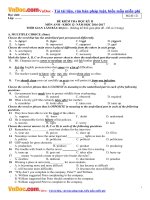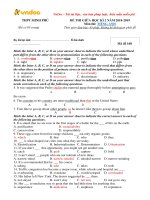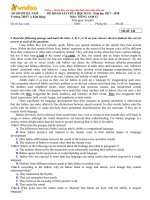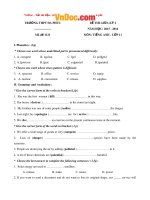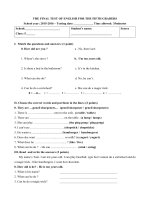Đề thi học kì 2 môn Tiếng Anh lớp 12 năm 2020-2021 có đáp án - Trường THPT Lương Thế Vinh, Quảng Nam
Bạn đang xem bản rút gọn của tài liệu. Xem và tải ngay bản đầy đủ của tài liệu tại đây (270.78 KB, 9 trang )
SỞ GD & ĐT QUẢNG NAM
TRƯỜNG THPT LƯƠNG THẾ VINH
ĐỀ CHÍNH THỨC
(Đề có 4 trang)
KIỂM TRA CUỐI HỌC KÌ II – NĂM HỌC 2020 - 2021
MÔN TIẾNG ANH - KHỐI LỚP 12
Thời gian làm bài : 45 Phút
Họ tên : ............................................................... Số báo danh : ...................
Mã đề 801
Mark the letter A, B, C or D on your answer sheet to indicate the word(s) CLOSEST in
meaning to the underlined word(s) in each of the following questions.
Question 1: John, could you look after my handbag while I go out for a minute?
A. take part in
B. take up
C. take care of
D. take over
Question 2: Toxic chemicals in the air and land, contaminated water and increased water
temperatures have also made a lot of animals become extinct.
A. polluted
B. purified
C. salt
D. dirty
Mark the letter A, B, C, or D on your answer sheet to indicate the sentence that best combines
each pair of sentences in each of the following questions.
Question 3: As he grows older, he becomes increasingly intelligent.
A. The older he grows, the more he becomes intelligent.
B. The older he grows, the more intelligent he becomes.
C. The more old he grows, the more he becomes intelligent.
D. The more he grows old, the more he becomes intelligent.
Question 4: Tom was not at home either. Perhaps he went out with his girlfriend.
A. Tom probably goes out with his girlfriend.
B. Tom might have gone out with his girlfriend.
C. It is sure that Tom went out with his girlfriend.
D. Tom must go out with his girlfriend.
Read the following passage and mark the letter A, B, C, or D on your answer sheet to indicate
the correct answer to each of the questions.
THE HISTORY OF BOOKS
Books have been around for thousands of years. When ancient civilizations first started developing
writing systems, they would write on just about anything from stone to tree bark. Ancient Egyptians
were the first to use paper-like materials, called "papyrus", which they made by pounding flat the
woven stems of the papyrus plant. It was not long before the ancient Egyptians began gluing
together papyrus sheets to form scrolls, which were the first steps toward books as you know.
The birthplace of bookbinding is considered to be India in the 2nd century B.C, where Hindi scribes
would bind palm leaves that were etched with religious texts between two wooden boards using
twine. The technique became popular in the Middle East and Eastern Asia, and spread to the
Romans by the 2nd century A.D. In the mid-15th century, German Johannes Gutenberg invented the
first mechanical printing press. His invention was revolutionary because it enabled mass
production of books for the first time. Before the printing press, a few pages per day could be
produced by hand-copying. Afterward, printing presses could produce as many as 3,600 pages per
day.
Today, modern publishers take advantage of incredible advances in technology to produce books in
many sizes and shapes very quickly. Although there are many types of processes and machines
available, most processes involve similar steps. Printers print the text of a book on large sheets of
paper, sometimes as large as a newspaper page. Working with large volumes of paper allows
Trang 1/4 - Mã đề 801 - />
printers to lower costs and produce books more efficiently. The large sheets are then cut into smaller
pages that are still about twice the size of a finished book. The smaller pages are then divided into
small groups, folded in half, and sewn together.
Question 5: According to paragraph 2, where was the first place to bind separate “sheets of paper”
to make books?.
A. India
B. Eastern Asia
C. the Middle East D. the Romans
Question 6: The word “revolutionary” in paragraph 3 mostly means ……
A. successful for the first time
B. not important or serious
C. sudden, very great and often surprising
D. involving a great or complete change
Question 7: The word "they" in paragraph 1 refers to…………….
A. writing systems
B. papyrus
C. Ancient Egyptians
D. paper-like materials
Question 8: Which of the following does the passage mainly discuss?
A. How books are printed
B. How books are made
C. How books are finished
D. How books are invented
Question 9: According to paragraph 3, how to produce books more cheaply and efficiently ?.
A. Using many types of processes and machines
B. Producing books in many sizes and shapes
C. Printing the text of a book on small sheets of paper
D. Printing big amount of paper at the same time
Mark the letter A, B, C, or D on your answer sheet to indicate the most suitable response to
complete each of the following questions.
Question 10: Mary is talking to a porter in the hotel lobby.
- Porter: “Shall I help you with your suitcase?”
- Mary: “……………”
A. Not a chance.
B. I can’t agree more.
C. What a pity!
D. That’s very kind of you.
Question 11: Nancy and James are talking about their school days.
-Nancy: "I think school days are the best time of our lives."
-James: "…………. We had sweet memories together then."
A. Absolutely
B. That's nonsense
C. I'm afraid so
D. I doubt it
Mark the letter A, B, C, or D on your answer sheet to indicate the underlined part that needs
correction in each of the following questions.
Question 12: It is thought that classes in the university are more difficult than that in the college.
A. are
B. that
C. thought
D. in
Question 13: If you have any questions, rise your hand and I'll try to help you.
A. and
B. rise
C. have
D. to help
Mark the letter A, B, C or D on your answer sheet to indicate the word(s) OPPOSITE in
meaning to the underlined word in each of the following questions.
Question 14: An international medical conference initiated by Davison resulted in the birth of the
League of Red Cross Societies in 1991.
A. helped
B. started
C. finished
D. treated
Question 15: There have been significant changes in women's lives since the women's liberation
movement.
A. economic
B. controlled
C. natural
D. unimportant
Mark the letter A, B, C, or D on your answer sheet to indicate the sentence that is closest in
meaning to the sentence given in each of the following questions.
Question 16: They will build a factory in this area.
A. This area will be built a factory.
B. A factory will build in this area
C. A factory will be built in this area
D. This area will build a factory.
Trang 2/4 - Mã đề 801 - />
Question 17: It was wrong of you not to call the fire brigade at once.
A. You didn't call the fire brigade and it was wrong.
B. You should have called the fire brigade at once.
C. Calling the fire brigade must be done at once.
D. The fire brigade was called at the wrong time.
Question 18: It is compulsory for all the students to finish their class work before going home.
A. All the students may finish their class work before going home.
B. All the students needn’t finish their class work before going home.
C. All the students must finish their class work before going home.
D. All the students can’t finish their class work before going home.
Mark the letter A, B, C, or D on your answer sheet to indicate the word whose underlined part
differs from the other three in pronunciation in each of the following questions.
Question 19: A. parrot
B. control
C. sociable
D. opponent
Question 20: A. endangered B. provided
C. appealed
D. destroyed
Mark the letter A, B, C or D on your answer sheet to indicate the word that differs from the
other three in the position of primary stress in each of the following questions.
Question 21: A. generation B. conservation
C. disappearance
D. development
Question 22: A. language
B. devote
C. promote
D. conserve
Mark the letter A, B, C or D on your answer sheet to indicate the correct answer to each of the
following questions.
Question 23: She ………………. be ill. I have just seen her playing basketball in the school yard.
A. needn’t
B. can’t
C. mustn’t
D. shouldn’t
Question 24: I don’t know the meaning of this word. I will …………… it in the dictionary.
A. look up
B. get over
C. go off
D. take after
Question 25: We have to apply effective measures to save many plant and animal species
………….. extinction.
A. for
B. on
C. from
D. in
Question 26: A …………… is a very large wave, often caused by an earthquake, that flows onto
the land and destroys things.
A. tsunami
B. catastrophe
C. famine
D. flood
Question 27: ……….. is the existence of a wide variety of plant and animal species living in their
natural environment.
A. Individual
B. Globe
C. Conservation
D. Biodiversity
Question 28: The football match might …………. by the bad weather.
A. be postponed
B. have postponed C. postpone
D. be postponing
Question 29: John got ill and had to ……………. smoking.
A. get up
B. wash up
C. give up
D. make up
Question 30: Governments have …………..laws to protect wildlife from overhunting.
A. enforced
B. observed
C. enacted
D. required
Question 31: ………….. you study for these exams, ……………….you will do.
A. The hardest / the best
B. The more / the much
C. The more hard / the more good
D. The harder / the better
Question 32: This book is not really…………….. It is a waste of money buying it.
A. informative
B. information
C. informatively
D. inform
Question 33: As she did so, her parents became …………..
A. the most angry
B. the more angry
C. the angriest
D. angrier and angrier
Question 34: She hasn’t eaten anything since yesterday. She ………… be really hungry.
A. might
B. can
C. will
D. must
Question 35: Frank's wallet is lying on the coffee table. He …………….it here last night.
Trang 3/4 - Mã đề 801 - />
A. can't have left
B. must have left C. must leave
D. should have left
Read the following passage carefully and then choose the best option to fit each numbered
blanks.
BASKETBALL
One of the most popular sports in the world, played daily by millions of people had humble
beginnings. Basket Ball which was created in 1891 in a Springfield, Massachusetts YMCA
gymnasium __( 36 )__ into a game played worldwide more than 300 million people.
The person __( 37 )__ for the popular game was Dr. James Naismith (1861-1939). Dr. Naismith was
a Canadian-American Physical Education teacher at the School for Christian Workers located in
Springfield, Massachusetts. In 1891, under direction from Dr. Luther Gulick, the head of the
School, Naismith was given 14 days to create an indoor game. The goal of this directive was to
provide a creative and healthy indoor __( 38 )__ a rowdy class of students during the brutal New
England winter.
Naismith's __( 39 )__ did not happen quickly. He struggled to come up with a game that met the
objectives of his directive. At first he thought to bring outdoor games such as soccer or lacrosse
inside. However, such outdoor games were not feasible due mainly to the small indoor space of the
school gymnasium.
It is believed that Naismith drew up the rules of his new game of Basketball in about an hour. Most
of these rules still apply today. The game of Basketball became an instant success. The students
found the game easy to play and the rules easy to understand. __( 40 )__, the idea of getting a good
exercise workout without having to go outside in the very cold winter was very attractive to the
players and the coaches. The fans also liked the idea of not having to go outside in the cold to watch
this new and fun game.
(Source: />Question 36: A. has grown
B. have grown
C. grows
D. grew
Question 37: A. responsible B. blamed
C. suitable
D. available
Question 38: A. with
B. to
C. for
D. at
Question 39: A. invention
B. invents
C. invented
D. inventional
Question 40: A. Moreover
B. However
C.Therefore
D. Otherwise
------ HẾT ------
Trang 4/4 - Mã đề 801 - />
STT
1
2
3
4
5
6
7
8
9
10
11
12
13
14
15
16
17
18
19
20
21
22
23
24
Mã đề
801
802
803
804
805
806
807
808
809
810
811
812
813
814
815
816
817
818
819
820
821
822
823
824
Câu 1
C
C
B
A
D
B
B
A
D
D
D
D
D
C
C
A
B
A
C
B
D
D
A
A
Câu 2
A
D
B
A
D
B
B
A
D
C
D
A
A
C
D
A
C
B
B
B
C
D
C
D
Câu 3
A
C
C
D
A
D
A
D
C
B
D
A
C
B
D
D
B
C
A
C
C
B
B
D
Câu 4
B
B
D
C
B
B
A
A
B
B
B
A
C
C
D
A
D
C
D
C
A
C
B
C
Câu 5
A
B
A
C
A
B
C
D
C
C
A
C
A
A
A
D
B
D
C
B
C
D
C
B
Câu 6
D
D
A
B
D
B
B
A
C
C
D
A
C
C
C
D
A
B
A
A
C
D
C
A
Câu 7
C
B
A
B
B
A
B
D
C
A
C
D
A
B
B
A
A
A
D
C
C
D
A
C
Câu 8
B
C
B
A
B
B
A
B
C
D
C
D
C
D
A
A
B
A
A
B
B
A
A
A
Câu 9
D
D
D
D
B
D
A
C
A
C
B
C
B
D
A
A
D
A
D
D
A
A
B
B
Câu 10
D
D
B
A
B
B
D
B
D
D
B
D
C
B
A
A
D
C
C
D
B
D
A
A
Câu 11
A
A
D
D
A
B
B
D
B
B
B
D
D
C
D
C
B
B
B
C
C
A
C
C
Câu 12
B
A
C
D
C
B
B
B
D
B
D
C
A
C
B
D
D
D
A
A
C
A
A
D
Câu 13
B
D
A
B
C
D
D
B
A
C
A
C
B
C
C
C
A
B
C
D
C
D
B
B
Câu 14
C
B
A
C
C
A
B
C
A
B
A
C
A
D
B
B
B
D
A
B
A
D
C
B
Câu 15
D
D
A
B
A
A
C
C
B
C
D
B
B
B
B
B
D
C
B
B
C
C
A
A
Câu 16
C
C
B
D
D
B
D
D
A
B
B
A
D
C
B
C
C
C
D
B
D
B
D
B
Câu 17
B
A
A
A
C
B
D
B
D
D
D
D
C
A
B
D
D
A
C
A
B
B
C
D
Câu 18
C
C
A
B
B
C
C
C
B
C
D
C
D
C
B
A
A
A
B
B
D
D
A
D
Câu 19
A
C
C
A
B
C
C
C
C
A
B
B
B
B
C
C
D
C
B
A
B
C
A
D
Câu 20
B
A
B
B
B
C
B
D
B
D
B
B
A
A
C
A
C
D
B
C
C
C
A
D
Câu 21
D
C
B
B
A
C
B
C
C
C
B
A
C
A
C
C
A
D
C
C
B
A
D
A
Câu 22
A
B
C
D
C
A
C
C
B
B
D
C
D
C
A
B
D
A
D
A
C
A
A
B
Câu 23
B
A
D
A
B
A
A
A
C
D
C
D
C
A
D
B
A
C
D
A
B
C
A
D
Câu 24
A
A
C
D
D
A
D
B
A
C
B
D
B
C
A
A
B
A
D
A
C
B
A
C
Câu 25
C
C
B
D
D
C
B
C
C
D
B
B
A
C
D
A
A
B
C
D
A
A
B
A
Câu 26
A
D
A
B
B
B
C
B
D
B
D
D
A
D
D
B
B
A
B
C
D
B
B
D
Câu 27
D
B
B
A
B
C
B
D
D
C
D
A
D
D
A
D
B
B
D
D
A
A
B
B
Câu 28
A
C
A
D
C
B
B
B
B
B
B
A
B
A
A
D
C
B
D
C
A
C
D
C
Câu 29
C
B
B
C
B
B
C
B
B
D
A
A
A
D
C
B
A
C
B
B
D
B
A
D
Câu 30
C
B
C
A
B
A
C
B
B
D
B
D
D
C
D
B
B
C
D
D
A
C
A
A
Câu 31
D
C
B
A
A
C
A
C
A
D
A
B
D
A
C
C
A
D
A
A
B
B
A
D
Câu 32
A
C
B
C
C
C
B
A
D
D
B
B
A
A
C
A
A
A
A
A
C
B
B
A
Câu 33
D
C
A
B
B
B
B
C
C
C
A
B
A
A
A
A
B
C
A
A
B
B
D
A
Câu 34
D
D
A
B
A
C
C
D
D
D
B
D
A
C
A
C
B
C
B
D
C
D
C
A
Câu 35
B
A
A
B
A
B
A
A
B
D
A
B
D
C
D
A
B
D
B
D
D
A
B
A
Câu 36
C
B
B
D
C
C
A
D
A
D
A
C
C
A
B
B
A
D
B
A
A
B
A
D
Câu 37
A
A
A
D
D
B
C
A
C
D
D
B
A
A
D
D
B
A
A
C
B
D
D
A
Câu 38
A
B
C
C
D
B
D
C
A
A
C
A
C
B
C
C
B
B
C
C
B
A
C
B
Câu 39
A
A
D
D
D
C
D
C
A
D
C
C
D
B
B
C
A
B
B
D
D
C
B
C
Câu 40
B
C
B
C
B
B
D
B
C
A
D
D
B
B
A
B
A
D
A
D
C
A
D
D

